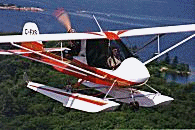|
Home Page | Order Challenger Video | Be Notified Of Web Site Updates | Contact Us
Herein are the older Challenger II 447 Legacy, 503 Deluxe, 582 Premium
which have been replaced by new 582 powered Challenger Light Sport models. The first Challenger flew way back in 1983 and took the ultralight industry a great leap forward. Instead of resembling hang gliders or lawn chairs with chain saw motors, Challengers looked and flew like actual airplanes. The cruise speeds of the era were nearly doubled and suddenly pilots could fly in real world winds and weather instead of only during the calm of sunrise and sunset. Early owners made headlines and received awards for multi-thousand mile cross-country flights - without ground support vehicles in trail! Today, some 4,000 airplanes and over 100 design changes later, the Challenger is dramatically more capable and maintains its position at the front of the pack. The Challenger now uses the latest version of the Rotax 503 and 582 engines, dual ignition powerplants designed specifically for aircraft. With thousands in use worldwide, they have the best reliability record of any light aircraft engines. These engines with the Challenger's new 2.6-to-1 reduction drive and bigger 60 inch prop generate substantially more thrust. This together with streamlining options available today translates into 30 mph more cruise speed, substantially higher climb rates, shorter takeoffs and zippier float operations. The new propulsion system is also much quieter. More recently, new ailerons were incorporated which reduce adverse
yaw and clean up air flow to the propellor. Also recently, new stronger main axles and nose gear plus a new braking system made ground handling more robust. And to ice the cake, on the inside new seats create a more spacious cabin for both pilot and passenger! It is very important to realize that older Challengers can not measure up to the most recent versions in terms of performance, reliability, appearance and even comfort. All these changes in the design are the result of many thousands of hours experience with the airplane in all types of flying conditions worldwide. Historians can view the changes year by year in the Evolution Time Line.
Herein are the older Challenger II 447 Legacy, 503 Deluxe, 582 Premium
which have been replaced by new 582 powered Challenger Light Sport models.
To learn and see more order our comprehensive information package and video! |


